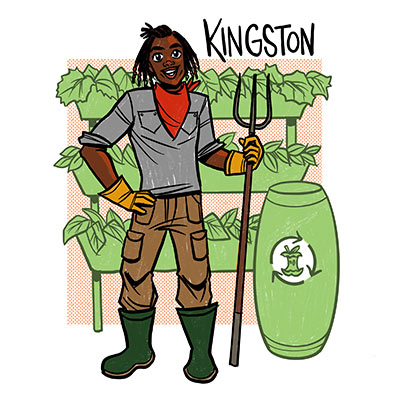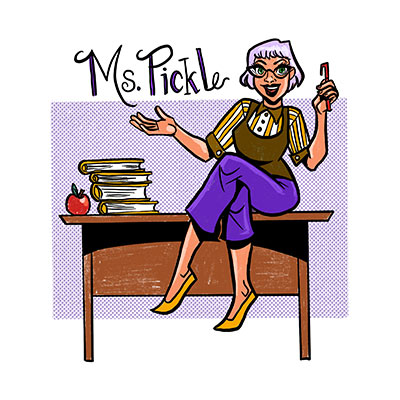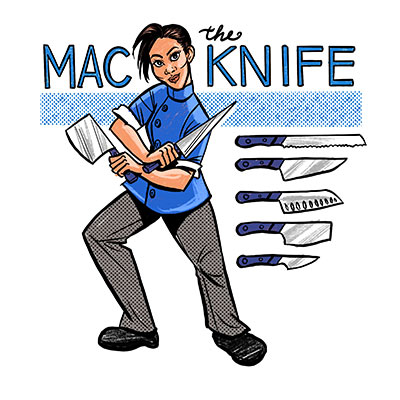Nobody Gets Hurt!
En Fuego has been a chef mentor to Chef Egg for years. His job as chef is to be the captain of the ship and ensure that everyone is working together safely, on budget and as a team. En Fuego’s knowledge, heart and ability to share his skills with his team has created a positive learning environment for all of his cooks.
Kitchen Safety
Fire Extinguisher: Always have one available in the kitchen. This should be used for paper, grease and electrical fires. Do not throw water on a grease fire; use baking soda to smother those flames.
Communication is Key: Speak up in the kitchen when working with and around other people. Always announce yourself when moving hot food or walking behind someone.
The Pot is HOT: Always assume that the handle of a pot or pan is hot. Use a dry kitchen towel or protective oven mitt when grabbing for hot handles and trays.
HOT HOT HEAT: Flames and steam will cause burns. Keep a safe distance from both.
First Aid: Keep a first aid kit handy in the kitchen or close by so you can care for any injuries right away. Keep it stocked with soap, band aids, gauze pads and fingercots so you can clean up and get back to work.
Call 911: If the injury is too much to handle on your own, call 911. If you feel you need to go to the doctor, urgent care or emergency room do so immediately.
Working in the Kitchen
Keep Yourself Clean: Follow good personal hygiene habits and wash hands often. You don’t want anyone to get sick.
Keep Your Work Space Clean: Staying organized and prepared in the kitchen will reduce the chance that you will hurt yourself or others in the kitchen.
Footwear: Wear closed-toe shoes. If something like a heavy pot or a knife falls, you will want your piggies to be protected.
Tools and Knives: Learn how to use knives and tools properly. Kitchen tools are not toys. If you don’t know how to use something, ask somebody.
The Right Tools: Use the proper tool for the job. Do not use a hatchet to cut lemons!
Cleaning Chemicals: Keep your cleaning chemicals in a safe place away from your food, pets and young kids.
Spills: Clean spills right away so no one slips and falls.
Kitchen Terms and Techniques
Beat or Whisk: To mix food in a bowl using a whisk at a fast pace. This will add air bubbles to the food and make it lighter and fluffier and add more volume.
Boil: To cook food in a large amount of water that has been heated to 212º F.
Braise: To sear the food over high heat then drop the heat to a low flame and add a flavorful liquid that will slowly cook the food until it is oh-so-tender and juicy. The meat will literally fall off the bone.
Broil: To quickly brown the top of your food in the oven. The high heat comes from above, and the food will burn quickly.
Caramelize: To cook your food slowly over low heat, allowing the sugars inside the food to heat up and intensify into a sweet flavor and dark color – just like sweet, gooey caramel.
Dice: To cut the food into identical cubes. You can make small, medium or large cubes. Cutting the food to a uniform size will ensure even cooking so the taste and look of the food will be on point in every bite.
Fold: To lightly mix food together with a rubber spatula, spoon or whisk so you combine ingredients but do not break down the volume of the food.
Grill: To cook food on grates using high heat. This can be done with gas, charcoal, or electric heat.
Mis en place: The French term “Mis en place” translates into “Everything in its place,” and it is the most important philosophy in the kitchen. Make sure that all of your food is prepped and your oven is preheated before you start cooking. You do not want to ruin your meal because you were unprepared.
Pallet: Your combined senses of sight, smell and taste that determine how you perceive the food.
Sauté: To make the food jump out of the pan while cooking over medium-high heat.
Sear: To brown the outside of the food using high heat. Searing creates a crispy crust on the food that seals in the juices and delivers an amazing caramelized flavor.
Slice: To cut the food into identical, thin strips using long, smooth cutting motions.
Soux Vid: This is a newer cooking style that cooks tightly plastic wrapped food in a warm temperature controlled water bath. This cooks the food to your desired temperature and ensures it does not overcook. Most cooks will sear food after they soux vid for a reverse sear.
Freeze Dry: Freeze drying food is a process of preserving food by freezing it to below zero temperatures and then removing the ice crystals with a vacuum. This process is known as sublimation and is used by NASA for astronaut food and the military for soldier rations.








